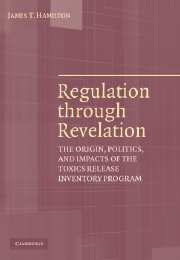 Regulation through Revelation
Regulation through Revelation Book contents
- Frontmatter
- Contents
- Acknowledgments
- Introduction
- 1 Legislating an Incomplete Contract
- 2 Defining Terms: Rulemaking and the Initial TRI Data Release
- 3 Spreading the Word in the Public and Private Sectors
- 4 Politics of Expansion and Contraction
- 5 Life Cycles in the Regulatory Environment
- 6 The Impact(s) of the TRI
- 7 Lessons from and for Regulatory Implementation
- Notes
- Bibliography
- Index
Introduction
Published online by Cambridge University Press: 24 November 2009
- Frontmatter
- Contents
- Acknowledgments
- Introduction
- 1 Legislating an Incomplete Contract
- 2 Defining Terms: Rulemaking and the Initial TRI Data Release
- 3 Spreading the Word in the Public and Private Sectors
- 4 Politics of Expansion and Contraction
- 5 Life Cycles in the Regulatory Environment
- 6 The Impact(s) of the TRI
- 7 Lessons from and for Regulatory Implementation
- Notes
- Bibliography
- Index
Summary
Searching for the real-life impacts of an environmental regulation can be hard. Industrial plants don't have signs on them that say, “Warning: (Costly) Environmental Regulations at Work.” Neighborhood yards don't have placards that say, “Another (Statistical) Case of Cancer Avoided Here.” Yet if a regulation improves environmental protection, plant decisions and neighborhood environments change. The overall impact of environmental policies consists of the aggregation of effects of particular regulations in particular places.
Consider the effects of one regulation – the U.S. Environmental Protection Agency's Toxics Release Inventory (TRI) program – in one place – Baton Rouge, Louisiana. Under the Emergency Planning and Community Right-to-Know Act of 1986, plants (primarily in manufacturing) with ten or more employees that produce or use quantities of toxic chemicals above a threshold must file reports with the EPA. For each of the nearly 650 chemicals covered in the TRI, a facility annually submits a report if it meets a chemical's reporting threshold. The TRI form tracks a plant's releases and transfers of a chemical broken down by where the toxic ends up: air, land, underground injection, surface water, public sewage, or off-site transfer (primarily to storage or disposal facilities). The form also contains information on facility management of production-related wastes and tracks pollution prevention activities at the site. Since the first release of TRI data in 1989 covering 1987 toxics data, the TRI has become a prime measure of a plant's or company's environmental performance.
- Type
- Chapter
- Information
- Regulation through RevelationThe Origin, Politics, and Impacts of the Toxics Release Inventory Program, pp. 1 - 9Publisher: Cambridge University PressPrint publication year: 2005
- 4
- Cited by


